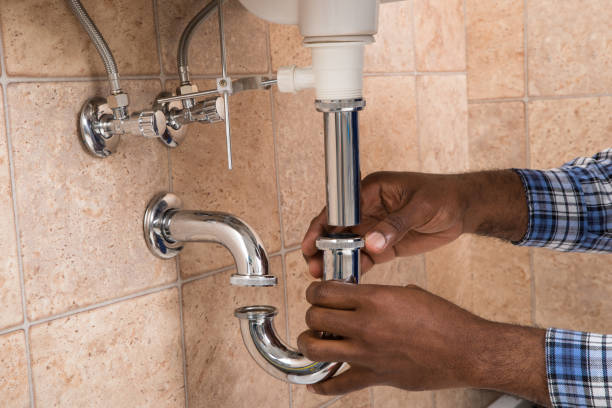Diving into the Basics of Home Plumbing: A Beginner's Tutorial
Diving into the Basics of Home Plumbing: A Beginner's Tutorial
Blog Article
Every person has got their own individual opinion involving Understanding the Basics of Your Home's Plumbing System.

Plumbing is an essential facet of any kind of home, responsible for providing clean water for drinking, food preparation, and showering, in addition to eliminating wastewater safely. Understanding the essentials of home plumbing is necessary for each property owner to guarantee proper upkeep, troubleshooting, and, if required, repair work. In this newbie's overview, we'll cover the fundamental principles of home plumbing to assist you become more accustomed to exactly how it works.
Water Supply System
The water system brings clean water right into your home from a community water resource or an exclusive well. It consists of a major water line that links to your home's plumbing system, usually situated underground. A water meter measures the quantity of water eaten, while a shut-off valve permits you to manage the circulation of water into your home.
Plumbing Components
Plumbing fixtures are tools that provide water to numerous parts of your home and include sinks, faucets, toilets, showers, tubs, and appliances such as dishwashing machines and cleaning devices. Each component is linked to the water system via pipelines and installations and may have its shut-off shutoff for maintenance or emergencies.
Water Heating System
The water heater is responsible for heating water for residential use, consisting of showering, cooking, and cleaning. Typical sorts of water heaters consist of tank-type hot water heater, tankless (on-demand) hot water heater, and heat pump water heaters. The water heater is attached to the water system system and supplies warm water to plumbing fixtures as needed.
Water drainage System
The drain system removes wastewater from your home and brings it away to a sewer treatment facility or septic system. It contains a network of pipes, installations, and components that carry wastewater from plumbing components to the main drain line or sewage-disposal tank. Correct drain is important to avoid clogs, back-ups, and sewage leaks.
Ventilation System
The air flow system aids keep correct air pressure and prevent sewer gases from entering your home. Vent pipelines, also referred to as vent stacks, prolong from plumbing fixtures to the roofing, enabling sewage system gases to run away securely outside. Ventilation pipes also enable air to go into the drain system, helping with smooth wastewater flow and avoiding suction or vacuum results.
Usual Plumbing Devices
Having the right devices handy is important for executing standard plumbing repair work and maintenance jobs. Typical plumbing tools consist of flexible wrenches, monkey wrench, pliers, pipeline cutters, hacksaws, plungers, augers (or drainpipe serpents), and Teflon tape. Having these tools readily available can aid you take on minor plumbing issues efficiently.
Standard Plumbing Fixings
While some plumbing repair services may require expert support, many common concerns can be attended to with basic do it yourself methods. Knowing how to take care of a leaky tap, unclog a drainpipe, change a toilet flapper, or fix a leaking showerhead can save you money and time on plumbing fixings.
Final thought
Understanding the essentials of home plumbing is necessary for each home owner to preserve a safe, practical, and efficient plumbing system. By acquainting yourself with the water system system, plumbing fixtures, drainage system, ventilation system, typical plumbing devices, and basic fixings, you can with confidence resolve small plumbing concerns and ensure your home's plumbing system operates efficiently.
Understanding Basics of Home Plumbing System: A Beginner's Guide
The Main Components of Your Home Plumbing System
The Water Supply System
This system is responsible for transporting fresh water into your home. It usually has a main water line that splits into two branches: one directed towards cold water services and the other connected to a water heater for hot water. The pressure is key here; it ensures water reaches all parts of your house.
The Drainage System
Once water has been used, it becomes wastewater that needs to be removed from your home. This is where the drainage system comes into play. It includes all the pipes that carry wastewater and sewage away from your house to sewage treatment facilities or septic tanks.
The Vent System
The vent system prevents sewer gases from entering your home and helps maintain the pressure balance that allows wastewater to flow out properly. These vents usually exit through the roof of your house.
Water Heating System
For those who enjoy hot showers or using hot water for cleaning, the water heater is a crucial part of the plumbing system. It can be a tankless system, which heats water on demand, or a traditional water tank model.
Common Plumbing Problems and Basic Troubleshooting
Plumbing systems, while designed to be durable, can face issues like clogged drains, leaky faucets, or low water pressure. Here are some basic troubleshooting tips:
Clogged Drains
Use a plunger or a plumber's snake to try and dislodge whatever is blocking the drain. Regular cleaning can prevent clogs.
Leaky Faucets
Often caused by worn-out washers or gaskets, these can usually be replaced by someone with basic DIY skills.
Low Water Pressure
This might be due to sediment build-up in your fixtures or a leak somewhere in your water line. Cleaning out aerators or seeking a professional to detect leaks might be necessary.
Preventive Maintenance Tips
Maintaining your plumbing system is key to avoiding emergencies. Regularly check for leaks, avoid disposing of grease down the sink, and have your system inspected by a professional plumber at least once a year.

I came across that entry on Plumbing basics: How your home plumbing works while surfing the web. Sharing is caring. Helping people is fun. Thank you so much for your time invested reading it.
Schedule Now Report this page